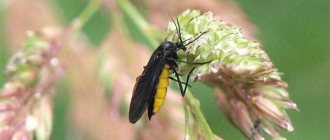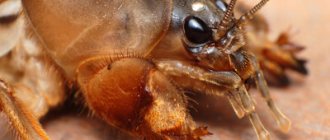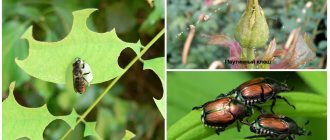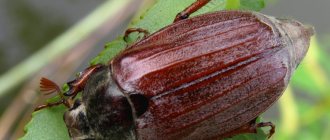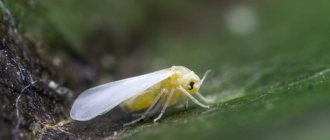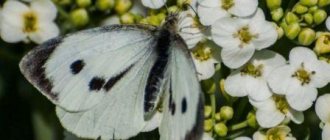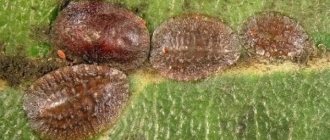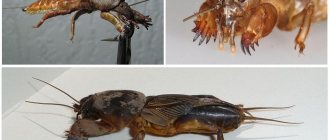Adult fungus gnats of the sciarid family Sciaridae are black flies with an elongated body, about 3-4 mm long, which lay their whitish, translucent eggs in the roots of plants. Young, newly emerged mosquitoes can be about 1.5-2 mm light gray in color. The mosquitoes themselves, if they start, usually fly in large numbers, but do not cause harm, except for the diseases they carry and the larvae of other pests. And the larvae of the fungus gnat - whitish worms about 3-5 mm long with a black head - eat the root system of plants, as a result of which it withers, lags in growth, does not bloom, and often reaches complete death.
What is an insect
The fungus gnat, a photo of which is shown in the figure below, is also called sciara fly.
Belongs to the order Diptera, family Sciaridae. The mosquito is a small insect with a narrow oblong body 1.5-4 mm in size. The color is black and gray. Moreover, the color of the body becomes darker as the individual “gets older.” The head is rounded with long antennae. Mouthparts are sucking. The wings are only the front ones, they are transparent. But they fly well. The hind pair of wings are transformed into club-shaped halteres. Due to this, a characteristic sound can be heard during flight. Adults do not harm plants. They do not bite or suck blood. They don't get into your eyes. But they can be carriers of various fungal diseases that harm both plants and people.
Life expectancy is approximately a week. But during this time the insect manages to lay up to 300 eggs. The female lays eggs on the surface of moist soil or in the soil between the roots. A few days later, larvae emerge from the eggs. They have no legs and resemble worms.
Fungus gnat larvae are transparent, with a clearly visible intestine and a black “head”. It is the “head” that is the distinctive feature by which sciarids are distinguished from other types of larvae. The length of the larva reaches 8-10 mm. Their mouthparts are gnawing. They feed on plant remains that decompose in the soil. In flower pots when food is scarce, they eat plant roots and young shoots in the soil. This causes irreparable harm to plants. A few days later, pupation occurs and a young midge appears. The remaining shells decompose in the ground. The larvae do not like dry soil. If they are taken out of damp soil into the air, they quickly die.
Sciarids are often confused with Drosophila. If the former have a “slender” body, then the latter are thicker. The mosquito has a head and chest larger than the rest of the body, and a thin abdomen. And Drosophila has no differences between the chest and abdomen.
Diseases affecting seedlings
Soil mold
pHPrevention measures:
- make sure that the plants receive enough light,
- avoid waterlogging the soil,
- add ash or lime to the soil mixture in advance for alkalization.
Root rot
How to recognize this disease? The lower leaves begin to turn yellow, and then turn brown and dry out. Dark spots and stripes, sometimes cracks, appear on the stem. The bottom of the stem darkens. It is very difficult to cure diseased plants: you will have to get rid of them. We will save those who remain.
Control measures:
- remove all plants with signs of disease,
- reduce watering and reduce air humidity,
- pour calcined sand or steamed soil into the seedling containers in a layer of 2 centimeters. This is necessary to stimulate the growth of additional roots,
- spray ash or crushed charcoal over the surface of the soil,
- twice a month, add biofungicides to the irrigation water (Fitosporin, Baktofit, Alirin-B, Gamair, Fitolavin, Strekar, etc.).
Prevention measures:
- choose varieties that are resistant to root rot,
- check the soil mixture for acidity. Add ash or lime to acidic soil
- treat the soil before sowing seeds for seedlings by steaming or freezing,
- a few days before sowing, water the soil with a solution of biofungicides,
- if the seeds are not treated by the manufacturer, be sure to soak them in a good disinfectant before sowing,
- do not thicken the crops or thin out the seedlings in a timely manner,
- Water the seedlings rarely, only when necessary.
Blackleg (root collar rot)
We talked about how to protect seedlings from blackleg in a separate article: Control and prevention of blackleg in seedlings.
Fusaria wilt
- the tops of the seedlings wither,
- leaves become variegated, yellow-green,
- leaves curl and fall off.
Plants acquire a stunted, depressed appearance and sooner or later dry out and die. Even if fusarium affects mature plants, there is no 100% effective treatment. Treatment even with industrial fungicides (like Topsin-M or Fundazol) only inhibits the development of the disease. In the case of seedlings, the best control is prevention.
The only way to save yourself is to carefully cut off the tops of the seedlings and inspect the stem. If the cut looks healthy and there are no black spots on it, you can try rooting the tops in a solution of a root formation stimulator. For example, in Kornevin, Epin, succinic acid. Tomatoes grow roots well and quickly, so this may work. Preventive measures:
- choose hybrids and varieties resistant to fusarium,
- steam, freeze the soil or add Trichodermin to it before sowing seeds for seedlings,
- If the seeds are not treated by the manufacturer, carry out pre-sowing preparation. Even simple heating kills infection on the seeds.
Biological characteristics of the fungus gnat
The sciarid fly is a small mosquito whose body length ranges from 1.5 to 4 mm. In young individuals it reaches two millimeters. The color of the outer cover of adult insects is black, while that of young insects is light gray. The fungus gnat has a well-developed front translucent pair of wings, thanks to which they can fly well. The hind wings have lost their original purpose. They have transformed into club-shaped halteres, so during flight the insect makes a characteristic squeaking sound. The sciarid's mouthparts perform a sucking function.
Adult sciarids do not harm plants because they do not feed. Under favorable conditions, insects reproduce very quickly. The female fungus gnat lays eggs on the surface of well-moistened soil or in clods of soil between the roots of indoor plants. One clutch can contain up to three hundred eggs. After a few days, worm-shaped, legless fungus gnat larvae emerge from them. Their body length can range from two to ten millimeters. It is translucent, with a clearly visible intestine and a characteristic black head. It can be used to distinguish representatives of flower pests from annelids. Sciarid larvae have gnawing mouthparts. They usually develop on rotting plant debris present in the soil. However, being in the flower pots of indoor plants, they may lack food substrates. Midge larvae feed on delicate food systems and underground shoots of flowers, causing irreparable damage to plantings. After some time, pupation occurs and the young fly emerges. Leftover shells decompose in the ground. Please note that they do not tolerate dry soil. Sciarid larvae removed from a moist substrate die within a short period of time.
At what temperature do sciarids die?
Sciarid flies (fungus gnat)
Sciara fly, order Diptera -
family Sciaridae (sciarids) a small black-gray mosquito about 1.5 mm long with a narrow body and a rounded head. The insect has only a front pair of transparent wings; the hind wings are transformed into club-shaped halteres. Mouthparts are sucking. They fly well and, in suitable conditions, easily reproduce in large numbers.
Adults do not harm plants, but lay small eggs on the surface of moist soil. Larvae later appear from the eggs - translucent, legless worms with a black “head” measuring 8-10 mm. The mouthparts are gnawing. Typically, the larvae develop in the soil on rotting plant tissue. However, indoor culture often lacks food substrates, as a result of which tender young roots and underground shoots of plants can be gnawed, which poses the main danger.
What is important to know about fungus gnats in order to successfully fight them?
There is no need to panic if large numbers of flying flies suddenly appear at home. First, you should try to figure out who they are and where they came from, and depending on the result obtained, choose a method of getting rid of them.
Do not confuse them with the fruit fly Drosophila! First, look at the flying specimens and make sure that they are sciarids. Mosquitoes, compared to Drosophila, are graceful and slender. The head and chest are larger than the body, the abdomen is thin, approximately 0.5 mm. Drosophila is a fly, albeit a small one. The abdomen has the proportions of a fly, thicker, without a sharp difference between it and the chest. It appears more often on spoiled fruits, hence the name.
Now, after digging up the soil a little, see if there are sciarid larvae there. If not, then everything is great: it is enough to destroy only the flying mosquitoes, which is not so difficult.
Reasons for appearance
As a rule, flies come to the grower with soil contaminated with their larvae, from which, under favorable conditions, adult flying insects hatch.
It is important to check the quality and carry out preventative treatment of the soil in which you plant the plant, but the presence of flying flies may not be related to your actions.
Often flies are a signal of an unfavorable environmental situation in the house. They did not necessarily come from the pot of a plant standing on the window. Like most insects, midges fly to the light, that is, to the window, next to which they enjoy sitting and flying, but they could have flown in from the outside.
These insects love a warm and humid atmosphere, so they live with great pleasure in damp basements of residential buildings and can visit through hoods, pipes and ventilation shafts, especially in the toilet. Having flown into a gardener’s apartment, they may well take root, laying eggs on the surface of the soil of a recently watered plant and infecting it with their larvae.
Sciarids can also covet food waste (spoiled fruits, vegetables) in the trash can, and linger in the winter vegetable reserves (potatoes, onions). If you are “lucky”, they can find a home in a completely unexpected place, if your apple has rolled somewhere and remained unnoticed, for example, an apple (or its core, which is even worse). Here, treating your flowers with chemicals will not help; you must find and, if possible, eliminate the source.
External signs of sciarid damage
Small black flying insects appear in the room, fluttering from disturbed flower pots. However, the presence of flying individuals does not mean that there are larvae in the soil that harm the plant (larvae are an already advanced version of the problem).
The larvae are usually immediately visible if you dig a little into the soil. The soil itself is characteristically crumbly and, when dry, has a consistency similar to sand. The infected plant looks bad and stops growing.
Prevention
If the sciarids find favorable living conditions in the apartment, there will be no end to them. Therefore, you will have to find out the “tastes” of these insects and try to take preventive measures against their appearance and reproduction:
The main rule is to not allow the soil in the pots to become waterlogged.
If you constantly flood your plants, then adjust the watering: waterlogging the soil in pots creates conditions for the active reproduction of sciarids. Never water a plant again unless the top soil in its pot is dry! If you accidentally water the plant too much, drain the excess water from the pan and thoroughly dry the earthen ball before the next watering.
When insects appear, it is important to prevent their further reproduction and spread.
Adult flying individuals lay eggs on the moist surface of the soil, from which a large number of larvae live in the soil. If the soil surface is dry, the masonry will die, so keeping the top layer of soil dry is an excellent preventive measure against sciarids. Dry the top layer of soil regularly (1-2 cm in medium-sized pots, up to 3-4 cm in larger ones).
You can also use top drainage: cover the surface of the soil in the pot with a layer of fine expanded clay, gravel or coarse sand. After watering, such a layer quickly becomes dry and deprives insects of the opportunity to lay eggs.
Sciarids, like all insects, reproduce easily and very quickly - when the first flying individuals appear, take urgent measures to remove them.
Promptly remove dead parts of plants (withered leaves, flowers, underground parts) remaining in the pot. Monitor the state of the supply of vegetables and fruits in the apartment and your food waste, promptly remove and throw away everything that could become “home and food” for sciarids.
Use sterilized substrates for your plants.
It is good if the soil contains components that are “unpalatable” for flies: coarse fibrous peat, pine needles, bark, coal, coconut fiber. However, it must be remembered that the composition of the soil should first of all be selected in accordance with the needs of the plants, and not the flies.
If you are not sure about the cleanliness of the soil, spill it with water and freeze it for at least a few days (in the summer - in the refrigerator, in the winter - outside or on the balcony). It is safer to leave the soil prepared for future use on the balcony for the winter, and use it for replanting in the spring. Long-term freezing is a good remedy for many soil pests.
Do not use easily decomposing organic substances as fertilizers (tea leaves, coffee, fish bones, tree leaves, “meat” water, milk, kefir) - with further rotting in the pot, excellent conditions are created for the active growth and reproduction of sciarid larvae.
Do not allow water to stagnate in the pot, otherwise the roots will rot.
If, after all, the roots have rotted, then take measures: remove the plant from the pot, thoroughly rinse the roots in running water, trim off all rotten and damaged parts with a clean knife, dry plants with large or fleshy roots and treat with crushed charcoal or sulfur powder. Then replant the plant in slightly moist, fresh soil and water as little as possible for some time after replanting. It is better not to water a plant with fleshy roots at all: damaged by sciarid larvae, weakened roots are defenseless against rot pathogens.
In the spring, before sowing seeds, it is advisable to carry out a full range of preventive measures to prevent the appearance of fungus gnats in your home. Sciarid larvae greatly harm hatched seeds and young seedlings.
Ways to fight
A set of measures aimed at destroying all forms of fungus gnat
It is not necessary to perform all the suggested actions - determine the extent of damage to your collection and select what is necessary.
Important: approach the problem carefully and carefully. If you fight only larvae or only flying mosquitoes, there will be no benefit. When starting the “battle”, try not to deprive anyone of your attention, and then you are guaranteed success.
* Determine where and how they could get to you and check all possible places where mosquitoes “reside”. Carefully remove all organic debris and dead parts from the plants.
* If your mosquitoes are coming to you from the basement of your house through hoods, pipes and ventilation shafts, you are very unlucky. It is almost impossible to eliminate dampness in the basement, so mosquitoes, unfortunately, will become your regular guests.
* Install a very fine mesh on the ventilation grilles, through the holes of which mosquitoes will not be able to get into the apartment.
* Check the soil in the pot - if it is heavily infested with larvae, change it to a fresh, breathable soil mixture suitable for the composition of this plant.
* Check the root system of the plant: if there are signs of root rot, take action
* Gather all the plants in one room. It should be well ventilated, and it is better to have a high-quality hood.
* Treat the premises with one of the means against flying insects in the form of an aerosol, for example, “Raptor”, “Raid”, “Neo-dichlorvos”. Make sure that there is no food, utensils, personal items, etc. in the treatment area. Cover the aquarium, remove the cage with birds or small animals.
* Also spray the racks and window sills on which the plants stand to avoid “revenge” from surviving specimens in the future. Don’t forget to thoroughly clean all surfaces with soapy water and rinse several times with clean water.
* Any available insecticide is suitable for chemicals: Agravertin, Aktara, Inta-vir, Fitoverm, Aktellik, Kinmiks, Karbofos. Dilute the working solution according to the instructions and thoroughly water the soil in the pot twice with an interval of 7 days. After treating the soil with a pest control drug, you should not water the plants for at least 3-5 days, so as not to weaken the effect of the drug by reducing its concentration and being washed out of the soil coma.
* For larvae in the ground, soil insecticides are used, for example, Bazudin, Grom-2, Pochin. In pots infested with sciarid larvae, remove the top layer of soil (about 3 cm) and replace it with the following mixture: new breathable soil and several Bazudina granules. Or simply scatter the granules over the surface of the earthen clod and carefully mix them with the top layer. When watering, the drug will dissolve and penetrate into deeper layers, killing the larvae living there. However, it is convenient to use such products if there are few infected plants, otherwise it will take a very long time to lay out and mix the drug in each pot.
* Leave everything for a while, preferably overnight. Close the door tightly and leave the room. In the morning you can move the plants to their places.
* In the room where you carried out the treatment, open the windows or turn on the hood for a long time. Collect the “bodies” of the flying representatives of this pest that fell in the unequal struggle, and clean the premises.
You can get rid of flying insects in several ways:
*Collect with a vacuum cleaner.
* Treat the room with a drug against flying insects in aerosol form (“Raid”, “Neo-dichlorvos”, etc.).
* Use a special sticky fly trap tape hanging near the plants. Advice - stock up on sticky fly traps in the summer: in winter there are no traps in stores!
* Use “scotch tape” as a last resort: place small strips with the adhesive side up next to or on the pots.
* Close the windows and turn on one or more fumigators for a long time (depending on the size of the room and the number of plants), placing them as close as possible to the cluster of plants. You can use different plates, “Raid”, “Fumitox”, etc.), the main thing is to change them quite often, about once every 1.5 - 2 hours.
* An unconventional way: plant nepenthes, an insectivorous plant that can now be found in flower shops. It is supposed to “eat” all the midges. In principle, “there is” - it will be there, but not all of them, but only those who want to get into his jug. In addition, Nepenthes itself is not so easy to keep indoors.
* Sprinkle crushed Mashenka chalk (for cockroaches) or draw stripes on the top of the pots.
* Cover the plants with fresh citrus peels, pieces of garlic, branches of incense, sprinkle with dill, and coat the pots with anise oil. All of the above must be updated frequently. This method is effective if a couple of insects accidentally flew into your area and have not yet had time to get used to it, but, unfortunately, this moment is very difficult to detect.
Folk remedies for flying insects:
* Infusion of tobacco or shag – 40 g. dry tobacco infused in 1 liter. water for two days, then filter and add another 2 liters. Water. Spraying must be done 4-5 times every 5-7 days.
* Soap solution – 20-40 g of soap shavings are dissolved in 1 liter. water. Spraying must be done 4-5 times every 5-7 days.
To destroy (prevent) egg laying by insects, it is recommended:
* Replace the top layer of soil in the pot (about 3 cm) with looser, dry, sterilized soil.
* Dry the top layer of soil (1-2 cm in medium-sized pots, up to 3-4 cm in larger ones). However, keep in mind: not every plant can easily tolerate drought! And sciarid larvae can “sleep” in dry soil for quite a long time, so they will actually disappear for some time. This method is good to use for preventive purposes.
* Use top drainage: cover the surface of the soil in the pot with a layer of fine expanded clay, gravel or coarse sand up to 2 cm thick. Such a layer quickly becomes dry after watering and also deprives insects of the opportunity to lay eggs, while the root system of the plant will not suffer from drying out. You can also cover the soil with a circle of paper cut exactly to the size of the pot.
* A good effect can be achieved if you spill the soil in pots several times with a light pink solution of potassium permanganate.
…………
mod ol@
16
Description and appearance
Experts identify about 1.5 thousand species of this insect. But gardeners at home most often encounter only one of them, namely sciaridae.
Fungus gnat
The size of an adult insect is 3-4 mm. The fungus gnat has a narrow, elongated body and a rounded head. The color of the insect is gray or black. In the thoracic region there are three pairs of thin paws. In the frontal part there are elongated whiskers that help the insect navigate in space. The fungus gnat has one pair of transparent wings. Adults do not feed; their main function is to breed offspring.
Sciarid larvae
The larvae of the fungus gnat are worm-shaped and legless. Their body length at birth does not exceed 2 mm, and during development it reaches 10 mm. The larvae have a dark head and a transparent light body color, through which the intestines are visible. The mouthparts are gnawing type. Large larvae are capable of leaving a slimy trail on the soil surface as they move.
Reproduction and development stages
Female sciarids lay eggs on the surface of moist soil or directly into the soil near the roots of the plant. After 5-7 days, larvae emerge from them. They begin to actively feed, which determines their accelerated pace of development. The sciarid remains in the larval stage for 2 weeks. At the last stage of development, they become inactive, and their appetite decreases. After this, the sciarid larvae pupate.
After 3-4 days, adults emerge from them. And after a day, new adult sciarids are ready to independently breed offspring, and the cycle resumes. The lifespan of females is 3-4 weeks. During this period, the sciarid lays from 50 to 300 eggs. Optimal conditions for reproduction: temperature +240C and humidity level 75-100%.
The danger of fungus gnats for humans and indoor plants
It should immediately be noted that sciarid midges do not bite humans and do not drink their blood. This is confirmed by research by American scientists. They, unlike midges, do not swarm near the face and do not get into the eyes. However, sciarids are carriers of dangerous fungal diseases that are harmful not only to plants, but also to people. Severe respiratory diseases can develop in humans after contact with infected plants and inhalation of mold spores, which are carried by sciarid flies.
As for plants, the favorite food of indoor plant pests in the ground are the roots of poinsettia, Saintpaulia, anthurium, hibiscus, orchids and other houseplants. In pots where sciarid larvae have appeared en masse, flowers stop developing normally, they lose their attractive appearance, become lethargic and lose their ability to bloom. All this indicates that care must be taken to eliminate dangerous pests from indoor flowers as quickly as possible.
Why are they dangerous for flowers?
First of all, bugs pose a great danger to flowers, because each pest is essentially a parasite and deprives the flower of the nutrients necessary for full growth, development, flowering, and reproduction. They have a complex negative effect on the normal development of flowers, namely:
- They deprive the soil in which the plant grows of nutrients, thereby reducing the results of fertilizing and watering to zero;
- They destroy the leaves and buds of indoor flowers, depriving them of the opportunity to bloom;
- They deform blooming flowers and contribute to their drying out and rapid fading;
- The stems are undermined and thinned.
It should be borne in mind that the greatest harm is caused not by the pests themselves, but by their larvae. The larvae reproduce very quickly and are very voracious. Therefore, it is necessary to destroy, first of all, insect larvae and eggs. If the larvae accumulate on the leaves, it is best to take a small basin and place it next to the flower. Then the flower is carefully taken by the top and shaken so that all the larvae and eggs of harmful parasites fall into the basin.
The larvae and oviposition are then destroyed, for example by being flushed down the toilet. This method is quite effective if the larvae nest on the leaves and stem. If the larvae are hiding deep in the ground, it is best to transplant the plant into a pot with other soil.
Many insects are dangerous because their vital activity causes rotting of the root system. Also, many harmful insects leave their metabolic products on the roots, stems and leaves, for example, wet mucus, due to which the plant gradually rots and may develop a fungal infection.
Some types of insects entangle the leaves with their webs and thus prevent the normal “breathing” of flowers. But the greatest danger to indoor flowers are parasites that feed on stems and leaves. They are unusually voracious, and if measures are not taken to destroy them in time, they can almost completely destroy the leaves of a plant, just as the Colorado potato beetle destroys potato tops.
Reasons for the appearance of fungus gnats in an apartment
Fungus gnat in the house
To get rid of midges in indoor plants, it is necessary to establish the reason for their appearance in the room. The most common factors for the existence of fungus gnats in an apartment are:
- increased humidity in the apartment and improper care of house plants;
- purchasing a flower infected with sciarid larvae or adults from a specialized store;
- sciarid can enter the apartment through ventilation ducts, an open window or door;
- a warm and humid environment is an ideal condition for insect life. Having settled in such a room, they lay eggs in the flower substrate and continue to exist.
Having established how the sciarid flower flies ended up in the apartment, it is necessary to begin comprehensive measures to destroy the pests.
Protection by strengthening
| Small insect pests such as spider mites or thrips are clearly visible through a magnifying glass. |
- Algal limestone
, which is sprinkled on plant leaves, increases resistance to fungal diseases. In addition, it causes insect larvae to dry out.
- Algae extract
contains a lot of substances important for the structure of plants. It is available in liquid or powder form; both are applied to the leaves. This extract increases plant resistance to any pests.
- Silicic acid
included in many plant strengthening products. It makes fabrics stronger and increases resistance to harmful fungi.
- Essential oils
As plant strengthening products, they are usually sold under the name “Aromatic flower care product.” For indoor, balcony and tub plants they are sold in the form of sprays, and for spraying a large number of plants - in the form of a concentrate that needs to be diluted.
Preparatory activities
Before taking effective action to combat the pest of indoor plants, it is necessary to establish their number, their place of mass habitat, and only then decide how to get rid of sciarids and which method to choose. Initially you need to do the following:
- inspect the premises for the presence of food waste and establish ways of penetration of sciarids into the apartment;
- install protective nets on hoods and ventilation ducts;
- check the soil in flower pots for the presence of larvae and, if necessary, replace it with fresh substrate;
- conduct an audit of the root system of plants in order to detect rotten areas;
- reduce indoor air humidity through additional air ventilation.
After carrying out this set of measures, you can choose effective methods of combating the fungus gnat.
Common pests.
Aphids • Signs of damage: plant growth slows down, foliage may be sticky and deformed. • Methods of control: You can collect aphids with your hands, treat them with a stream of water, or use appropriate preparations.
Weevils • Signs of damage: holes can be found on the leaves; this pest is especially active at night. • Methods of control: We remove pests by hand. We water with water with pest control drugs diluted in it.
Mealybugs • Signs of damage: small, white, fluffy spots on the veins of leaves and shoots of plants. • Methods of control: remove with a cosmetic stick soaked in insecticide. Biological control methods can be used.
Spider mites • Signs of damage: red spiders, thin cobwebs on the leaves and frequent small specks. • Control methods: water the plants, as mites do not like wet soil
Biological control methods can be used.
Scale insects • Signs of damage: small, bronze insects sit firmly on the leaves and shoots of plants. • Methods of control: remove pests with a brush or cosmetic stick dipped in a suitable insecticide.
Springtails • Signs of damage: if you touch the ground, small, white beetles appear that jump quickly. • Methods of control: improve water permeability, add a little lime (careful if plants prefer acidic soil).
Whiteflies • Signs of damage: small, white flies on the leaves. May cause black plaque to appear. • Methods of control: an elusive pest, we use contact insecticide and biological control methods.
Prevention and pest control. Proper care and compliance with all requirements for growing indoor plants help prevent the occurrence of diseases and pests. Constantly inspect your plants for diseases and pests. Good luck to you.
General wrestling rules
Fungus gnat control will have maximum effect if it is aimed at destroying all forms of insects. These methods include:
- Treatment of the entire room with special aerosols to combat insects (Dichlorvos, Raptor, Raid and others). In this case, it is necessary to remove all food, personal hygiene items and similar items. Pets (birds, fish, puppies, etc.) also need to be isolated for a while.
- Treat window sills, shelves and other places where plants stand. This will help prevent the surviving specimens from developing. The treated areas will then need to be thoroughly washed with soap and water.
- Use insecticides. Among them, the most popular are “Aktellik”, “Aktara”, “Fitoverm”, “Karbofos” and others. The chemical is diluted with water according to the instructions. The resulting solution is used to water the soil in the pots twice at intervals of a week. To prevent the effectiveness of treatment from decreasing, it is recommended not to water the plant for the first days after treatment.
- When fighting larvae, “Bazudin”, “Thunder” and so on will help. When using them, it is necessary to replace the top layer of soil with a mixture of a new substrate with granules of the drug. When watering the plant, the product will dissolve and destroy pests.
Treated plants should be left for several hours (preferably overnight). Later they can be moved to their places. The room must be ventilated and all dead insects removed.
It is necessary to begin pest control when the first individuals appear. If the process is left to chance and the moment is missed, in a few days you will have to fight not only the flying midge. More eggs and larvae will appear, which will also have to be disposed of.
Chemical insecticides
Sciarida can be destroyed using effective chemicals. Before you start treating infected plants, you need to collect flying midges using a vacuum cleaner. The use of chemicals requires strict adherence to the recommendations set out in the instructions.
After applying insecticides, it is not recommended to water the treated plants for five days.
The following effective substances will ensure getting rid of mosquitoes:
- “Raid”, “Neo-dichlorvos” and other means of repelling flying insects, which should be used to treat the room where home flowers are located;
- “Karbofos”, “Agravertin”, “Aktara”, “Kinminx”, “Aktellik”, “Inta-vir” and other products that must be diluted in the appropriate proportion and watered on the contaminated soil;
- chalk “Mashenka”;
- soil insecticides “Pochin”, “Bazudin” and “Grom 2”.
These and other remedies for sciarids, if you follow the watering regime and properly care for the flowers, will help you get rid of pests.
Fighting fly eggs
To combat the eggs laid by the fungus gnat, the soil can be shed several times with a weak solution of potassium permanganate.
An effective remedy is the Citropak tablet. Its fourth part is diluted in 5 liters of water. The resulting solution is watered onto the soil. Just one treatment will bring tangible results. But the process can be repeated several more times to consolidate success.
Drying the soil in a pot can also bring positive results. But in this case, it is very important that the plant itself does not die. Its need for water must be taken into account.
Prevention.
It is not advisable to water the plants too much, because... Fungus gnats develop most intensively in moist soil. In soil mixtures from some manufacturers, fungus gnats are almost always present. Therefore, the soil must be sterilized before use. Sometimes mulching helps prevent the appearance of sciarids and reduce their number - you can cover the soil with a layer of sand or a cut out circle of paper. You cannot water plants with various “folk” remedies such as tea, broth or water left after meat. You should also regularly remove dry leaves and other organic debris from the soil surface, which serve as good food for the larvae.
How to fight fungus gnats with folk remedies
Among the folk methods of fighting mosquitoes, the most often used are:
- Using a vacuum cleaner, you can collect flying individuals sitting on flowers.
- Only insects that have flown into the room will leave if citrus peels, dill, garlic, and anise oil are placed around the pot.
- Buy a plant that feeds on insects. For example, Nepenthes. The disadvantage of this option is the difficulty of caring for such plants.
- Treat the plant with a soap solution (take 30 g of soap per 1 liter of water). Treatment is carried out 5 times at weekly intervals.
- Tobacco solution can also be used in mosquito control. To do this, infuse 40 g of dry tobacco in 1 liter of water for two days. After time, the solution is filtered and diluted with another 2 liters of water. Use the solution 5 times with an interval of 7 days.
- The use of ash is based on the appearance of an alkaline environment that mosquitoes cannot tolerate. The ash is scattered over the surface of the pot. Under the influence of water (during watering the plant), ash forms an alkaline environment.
Whitefly
| This is a small white insect with wings. Its green larvae suck out the juice. Leaves may fall. Whiteflies reproduce very quickly. Whiteflies usually hide on the undersides of leaves. On the upper side of the underlying leaves, a shiny coating (honeydew, or honeydew) appears - insect excrement, on which sooty fungi ("black") subsequently develop, due to which the surface of the leaf becomes first white and then black. |
Fighting methods:
- Whiteflies do not like low temperatures, so you can move the plant to a cooler room. Since whiteflies fly, they can be caught using sticky strips (available at fly catching stores);
- Herbal infusions against insects - they are sprayed on plants. Garlic infusion is relatively effective. Pour crushed garlic cloves (150-170 g) into 1 liter of water and leave in a tightly sealed container for five days. For spraying, 6 g of concentrate diluted in 1 liter of water is sufficient. Keep in mind that folk remedies can help if there are not too many pests;
- Glue traps can be used to catch adults. To do this, take pieces of plywood or hardboard, paint them yellow or white and grease them with Vaseline, rosin with honey or castor oil. Insects, attracted by the bright yellow or white (preferably yellow) color, land on these baits and stick. When there are a lot of them on a piece of plywood, they wipe it and lubricate it again with the same solution. You can also use sticky fly traps;
- "Aktara" according to the instructions;
- "Aktellik" according to the instructions;
- "Verticillin J" according to the instructions;
- "Confidor" (20% VRK) according to instructions;
- "Mospilan" (20% RP) according to instructions;
- "Pegasus" (25% EC) according to instructions;
- "Fufanon" (57% EC) according to instructions;
- "Phosbecide" according to instructions.
Tips on how to deal with fungus gnats in flowers
Christiana: It’s not the insects themselves that pose a danger to the plant, but their larvae! If there are a lot of them, then it is better to change the soil to fresh, loose soil. You can also water it several times with a manganese solution, only very weakly, so as not to burn the roots. As I heard, this is a very good remedy.
Weselova: Only Grom-2 helped me.
Kasandra: POCHIN always helps me, lightly sprinkle the soil on top or when replanting, add it to the soil. Choose what you have available in stores.
Elena T: Bazudin didn’t help, the actor helped. I don’t recommend mixing both drugs; I developed mold. For flying insects, you can hang trap tapes. But if you overdo it with watering, they will appear again.
Lusi: Fungus gnats and their larvae are not such a terrible beast. Well, firstly, if you have a lot of these mosquitoes, then this is a clear sign that you are flooding your flowers; this is much worse than mosquitoes. Take a break from watering, dry the flowers well, so that the soil is dry for about half of the pot. Buy bazodin, dilute it according to the instructions and water all the plants, you must water everything and abundantly so that the water leaks out and does not flow like a river from the pan, wait 15 minutes and drain the excess water from the pans. And after two weeks, for prevention, dilute potassium permanganate (so that the water is slightly pink) and water again.
irina-bahus: I water it with Inta-Vir, it always helps.
K.I.S.: They really love moist soil - that’s why it’s difficult to fight them. The larvae hatching from the eggs eat organic matter, and when there is little of it, they suck everything from the plant. I had them in a pot with hibiscus, when I had to shake out the pot, it was almost all white at a depth of 1 cm. I found the “Bazudin” product. You just need to sprinkle (a little) small granules on the soil around the plant and water it. There will be a nasty smell, it will go away after a while, but will recur when watering. This will kill the larvae. And the midges themselves die over time. The main thing is that juveniles do not form, and this remedy seems to help. At least they don’t fly for me anymore.
Lynx: I declared war on these dirty tricks! She grabbed a basin, filled it with 5 liters of water and threw in an Inta-Vir tablet. Well, in general, there was no nasty smell... and no sense either.... The next day I found these white worms in an absolutely mobile state. Then the next day I bought two ampoules of Actellik. Dissolved in water. White as arsenic (Mamma Mia, what a stink!). I took the flower (coleus) to the balcony and poured it with a liquid prepared in advance (actellik, ampoule per liter of water).
Orchid: I know that many people deny this, but personally, I successfully fight fungus gnats with liquid Raptor. Or rather, lately they prefer not to start (Raptor turns on every evening). I use the odorless Raptor liquid fumigator. Simple (30 nights) and somehow enhanced (45 nights).
evridika: The store recommended Tavric to me. You spread it on the soil in a dense layer, it destroys fungi and parasites, and fertilizer at the same time. It’s also different colors, it looks like coconut flakes, only in color.
Masha: How I overcame mosquitoes - actellik + fly tape. Water with Actellik - and lay the tape near the ground... the important thing is that it is better to place it directly on the ground of the pot... and not just next to it... Actellik kills larvae in the ground (only it is terribly smelly), and the tape catches adults - also with a bang. You can repeat the actellik in a week... I advise you not to remove the tape for a month.
Vika: Take a pack of inexpensive cigarettes, tear them and sprinkle tobacco on the ground so that the entire area of the pot is covered. Let this tobacco lie until it dissolves itself
Methods of treatment.
There are a great variety of ways to treat plants from sciarid invasion. First of all, it is advised to reduce watering the plant so that the soil dries to a depth of 2.5-5 cm. However, from my own experience I cannot call this measure at all effective. Reducing watering of Saintpaulias, for example, led me to their terrible dissatisfaction; the plants dropped their leaves and looked offended and depressed. And the sciarids flew and continued to fly. Of course, such abuse of plants must be continued long enough to starve out the hated mosquitoes, but, unfortunately, not every flower can withstand a period of prolonged drought, and there are some for which it is generally contraindicated.
You can try to catch flying insects with a vacuum cleaner or with yellow adhesive tape, which is best placed horizontally relative to the soil. You can water the soil with water with citromon or askofen (half a tablet per 3-4 liters of water).
Sometimes sticking half a clove of garlic or orange peels into the soil helps. It is recommended to use means to combat blood-sucking insects such as “Raptor”, various aerosols, fumigators, etc. However, fighting adult insects does not help in any way to get rid of the larvae.
You can also coat the edge of the pot with all the well-known Mashenka chalk.
You can remove the top layer of soil to a depth of 1.5-2 cm and replace it with sand. Insects do not lay eggs in sand, which will ensure quick disposal of sciarids. You can lure the larvae using potatoes. Small cubes of potatoes or carrots (about 3.5 cm) should be placed on the surface of the soil for 2-3 days. The larvae will crawl straight to it and begin to actively eat. Soon you will be able to see how many of them have gathered under the potatoes. It, of course, will need to be removed along with the larvae to prevent rotting.
I don't think the damage caused by sciarids is so great that insecticides need to be used. However, if you do not have any prejudices against chemistry (and in vain), and the number of insects has become simply catastrophic, you can water the soil with Aktara. In general, insects multiply very strongly, mainly in winter, when the heating is on. In the spring, if the humidity in the apartment decreases, the number of insects drops sharply.
The article uses photos from the following sources:
Preventive measures
Preventive measures must be followed to prevent pests such as sciarids from infesting your indoor flowers. The following will prevent the appearance of the insects we are studying.
- The soil that you have prepared for planting or replanting a houseplant should be clean, free from residues and rot.
- Before pouring the soil into the pot, treat it with potassium permanganate and sprinkle with charcoal.
- You need to wash the pot with hot water before using it, and also disinfect it with the same potassium permanganate.
- Coarse sand, ceramic fragments, expanded clay, and gravel will provide drainage. Sprinkle it over the top layer of soil.
- Don't go overboard with organic fertilizers: add moderate amounts of compost and manure to the soil.
- Coffee grounds, tea leaves, and dairy products such as kefir and milk do not make good fertilizers.
- Houseplants should be watered exclusively with clean water.
- If there is excess water left in the flower tray after watering, it should be poured out.
- Plants should not be watered frequently. Only after the top layer of soil has dried can the watering procedure be repeated.
- Rotting remains of indoor flowers need to be disposed of in a timely manner.
If you comply with the above conditions, flower gnats will not appear in your plants at home.
